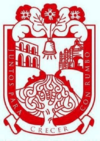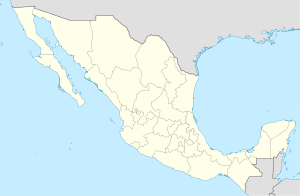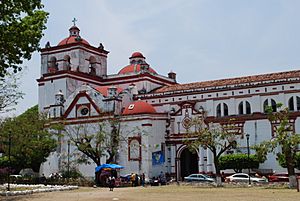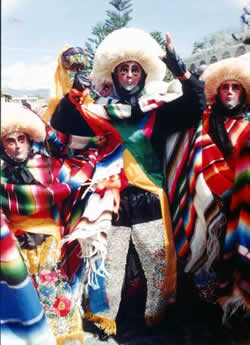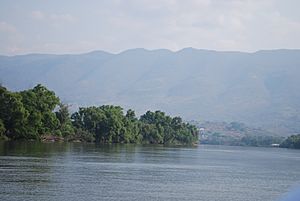Chiapa de Corzo, Chiapas facts for kids
Quick facts for kids
Chiapa de Corzo
|
||
|---|---|---|
|
Municipality and town
|
||
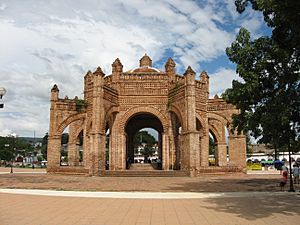
La Pila Fountain in the main square
|
||
|
||
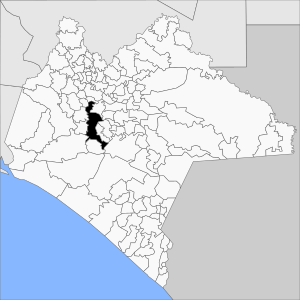 |
||
| Country | ||
| State | Chiapas | |
| Founded | 1528 | |
| Municipal Status | 1915 | |
| Area | ||
| • Municipality | 789 km2 (305 sq mi) | |
| • Seat | 16.26 km2 (6.28 sq mi) | |
| Elevation
(of seat)
|
420 m (1,380 ft) | |
| Population
(2020 census)
|
||
| • Municipality | 112,075 | |
| • Density | 142.05/km2 (367.90/sq mi) | |
| • Seat | 55,931 | |
| • Seat density | 3,439.8/km2 (8,909.0/sq mi) | |
| Time zone | UTC-6 (Central (US Central)) | |
| • Summer (DST) | UTC-5 (Central) | |
| Postal code (of seat) |
29160
|
|
| Area code(s) | 961 | |
| Climate | Aw | |
Chiapa de Corzo is a lively city and municipality in the state of Chiapas, Mexico. It's located in a valley near the Grijalva River, about 15 km (9.3 mi) east of Tuxtla Gutiérrez, the state capital. This area has been home to people for a very long time, since at least 1400 BCE. An important ancient site here was at its busiest between 700 BCE and 200 CE. It's famous for having the earliest known date written down, the first form of hieroglyphic writing, and the oldest tomb burial in Mesoamerica. Chiapa de Corzo is also where the first Spanish city in Chiapas was founded in 1528. The "de Corzo" part of the name was added later to honor a politician named Angel Albino Corzo.
Contents
Exploring Chiapa de Corzo
The town of Chiapa de Corzo is about 15 kilometers (9.3 mi) from Tuxtla Gutiérrez. It's connected to San Cristóbal de las Casas by the Panamerican Highway. The town sits along the Grijalva River, which is an important waterway.
The Main Plaza and La Pila Fountain
The town is built in the Spanish style, with a very large main square, or plaza. This plaza is home to several important landmarks. The most famous is the La Pila fountain. It was built in 1562 in a Moorish style, shaped like a diamond and made of brick. It's quite large, measuring 52 meters around and 12 meters tall. It has eight arches and a round tower that was sometimes used as a lookout.
Another special feature in the plaza is the La Pochota tree, a huge Ceiba pentandra tree. Local stories say that the Spanish town was first built around this very tree. There's also a clock tower from the 1950s. Around the plaza, you'll find the town hall and the old home of governor Angel Albino Corzo. One side of the plaza has "portales," which are arched walkways with many shops.
Santo Domingo Church and Museum
The Santo Domingo Church and its old monastery are the biggest buildings in town. Locals call it the "Iglesia Grande" or Big Church. It was built in the mid-1500s and is one of the best-preserved churches from that time in Chiapas. It has a mix of architectural styles, including Moorish, Gothic, and Renaissance. Its main bell tower holds some of the largest bells in Mexico!
Next to the Big Church is the former Dominican monastery. This building has been restored and now houses the Museo de la Laca (Lacquer Museum). Lacquer work is a very important craft here. Artists use lacquer to decorate wooden items and gourds with beautiful, detailed designs. Masks for traditional dances, like the Parachicos, are also made this way.
Other Churches and the Municipality
Other important churches in town include the Calvario and San Sebastian churches. The Calvario Church, from the 17th century, was later remodeled in a Gothic Revival architecture style. The San Sebastian church is now in ruins but still shows elements of Moorish and Baroque styles.
The Chiapa de Corzo municipality includes the main town and many smaller communities. Most of these communities are rural. The municipality is known for its rolling hills and flat areas along rivers.
Fun Festivals and Traditions
The Fiesta Grande de Enero (Great January Festival) is the most important event of the year in Chiapa de Corzo. It happens every year from January 4 to 23. This festival honors local patron saints like Our Lord of Esquipulas and Saint Sebastian. In 2010, UNESCO recognized the "Parachicos in the traditional January feast of Chiapa de Corzo" as an important part of the world's cultural heritage.
The Fiesta Grande Schedule
The Fiesta Grande is a series of events throughout January. It's a time to give thanks for the past year.
- January 8: The festival is announced, and the "Chuntas" dancers perform.
- January 15: Feast day of Our Lord of Esquipulas.
- January 17: Day for San Antonio Abad, with a parade of Parachicos.
- January 18: Parachicos visit the graves of past supporters.
- January 20: Dedicated to Saint Sebastian, with traditional foods like pepita con tasajo served.
- January 21: A fireworks show recreates a historical "Battle of Puerto Arturo." This tradition started in 1599!
- January 22: A parade with floats, confetti, and music.
- January 23: The final day with a parade of dancers and a special mass. The festival ends with drums and flutes playing a sad tune.
The Parachicos and Chuntas Dancers
The Parachicos are the most famous dancers of the Fiesta Grande. They wear special costumes: a carved wooden mask that looks like a Spanish face, a helmet or wig made of ixtle (plant fiber) that looks like blonde hair, and a colorful sarape (blanket). They carry a metal rattle called a chinchin and sometimes a guitar or whip. The whips are used to gently tap people as a blessing.
The story behind the Parachicos goes back to colonial times. A rich Spanish woman named Doña María de Angula came to Chiapa de Corzo looking for a cure for her sick son. A local healer told her to bathe him in a lake, and he was miraculously cured! To entertain the boy, local people dressed up as Spaniards and danced, saying "para el chico" (for the boy). This is how the Parachicos tradition began.
Another type of dancer is the Chuntas. These are men dressed as women, representing Doña María's servants. They wear shirts and long skirts. Both Parachicos and Chuntas dance and march to the music of pipes, drums, and other instruments. They often give out food and small gifts to spectators.
The Nigenda family has been in charge of the Parachicos dances and processions for about 70 years. Their house is a meeting point for the dancers during the festival.
Nature and Geography
The municipality of Chiapa de Corzo has rolling hills and flat areas, especially along its rivers and streams. The main rivers are the Grijalva River and the Santo Domingo. The climate is warm and somewhat humid, with most rain falling from July to November. The average temperature in the city is 26°C (79°F).
The area used to have dense rainforests, but much of it has been cleared. You can still find wildlife like river crocodiles, coral snakes, iguanas, and opossums. Part of the famous Sumidero Canyon National Park is located here. The El Chorreadero state park is also in the municipality, known for its beautiful waterfall. Boats that tour the stunning Sumidero Canyon usually leave from the Cahuaré Docks in Chiapa de Corzo.
A Look at the Past
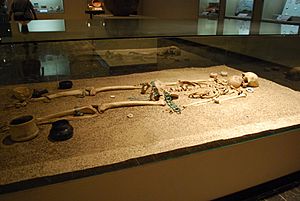
The Chiapa de Corzo region has been inhabited for thousands of years. Around 1200 BCE, people related to the Olmec culture settled here. The ancient site of Chiapa de Corzo was a major center from 1200 BCE to 600 CE. It was a key spot on trade routes between the Pacific and Gulf of Mexico coasts.
Ancient Discoveries
This archeological site is very important for several reasons:
- It shows a unique culture that mixed elements from the Mixe-Zoque people and the Olmecs.
- The oldest known Mesoamerican Long Count calendar date (36 BCE) was found here on a monument.
- A pottery shard with the oldest example of a writing system ever discovered was also found here.
A recent amazing discovery was the oldest pre-Hispanic tomb, dating back to between 700 and 500 BCE. It was found deep inside a pyramid. The person buried there was very important, with over twenty axes and thousands of pieces of jade, river pearls, obsidian, and amber as offerings. These items came from far away, showing how much trade happened back then. The face of the buried person was covered with a seashell mask, which is the earliest example of a funeral mask found in Mesoamerica.
Today, the ancient site is just outside the modern city. The Mexican government is working to protect more land around the ruins as the city grows. Parts of the site have been open for visitors since 2009.
Spanish Arrival and Colonial Times
By the early 1500s, the area was home to the Chiapa people, who were known for being strong warriors. They fought fiercely against the Spanish. In 1528, Diego de Mazariegos finally defeated them with the help of their enemies. The last Chiapa leader, Sanguieme, was captured and executed.
After the conquest, the Spanish founded a new town called Villa Real de Chiapa near the large La Pochota tree. This was the first European city in Chiapas. However, many Spanish settlers preferred the cooler mountains and founded another city, which is now San Cristóbal. Chiapa de Corzo became known as "Chiapa de los Indios" (Chiapa of the Indigenous people), left to the native people and the Dominican monks who worked to convert them to Christianity.
The Dominican friars helped protect the indigenous people from abuses by the Spanish. They also taught them new crafts like European pottery and fireworks making. The Dominicans built many of the town's famous landmarks, including the La Pila fountain. Because of this, many indigenous family names still exist in Chiapa de Corzo today.
Modern History
Chiapa de Corzo was officially declared a city in 1851. The "de Corzo" was added to its name in 1881 to honor the Liberal politician Angel Albino Corzo. In the 1970s, the building of the Chicoasén Dam caused some earthquakes, and one of them knocked down a large bell in the main church. A major highway connecting the city to San Cristóbal was built in 2000.
Demographics
As of 2010, the municipality of Chiapa de Corzo had a total population of 87,603 people. The city itself had 45,077 residents. The municipality also has many smaller communities. Most of the population is young, with an average age of twenty-one. Most people in the municipality are Catholic, but there are also many who belong to Protestant Christian groups.
See also
 In Spanish: Municipio de Chiapa de Corzo para niños
In Spanish: Municipio de Chiapa de Corzo para niños


